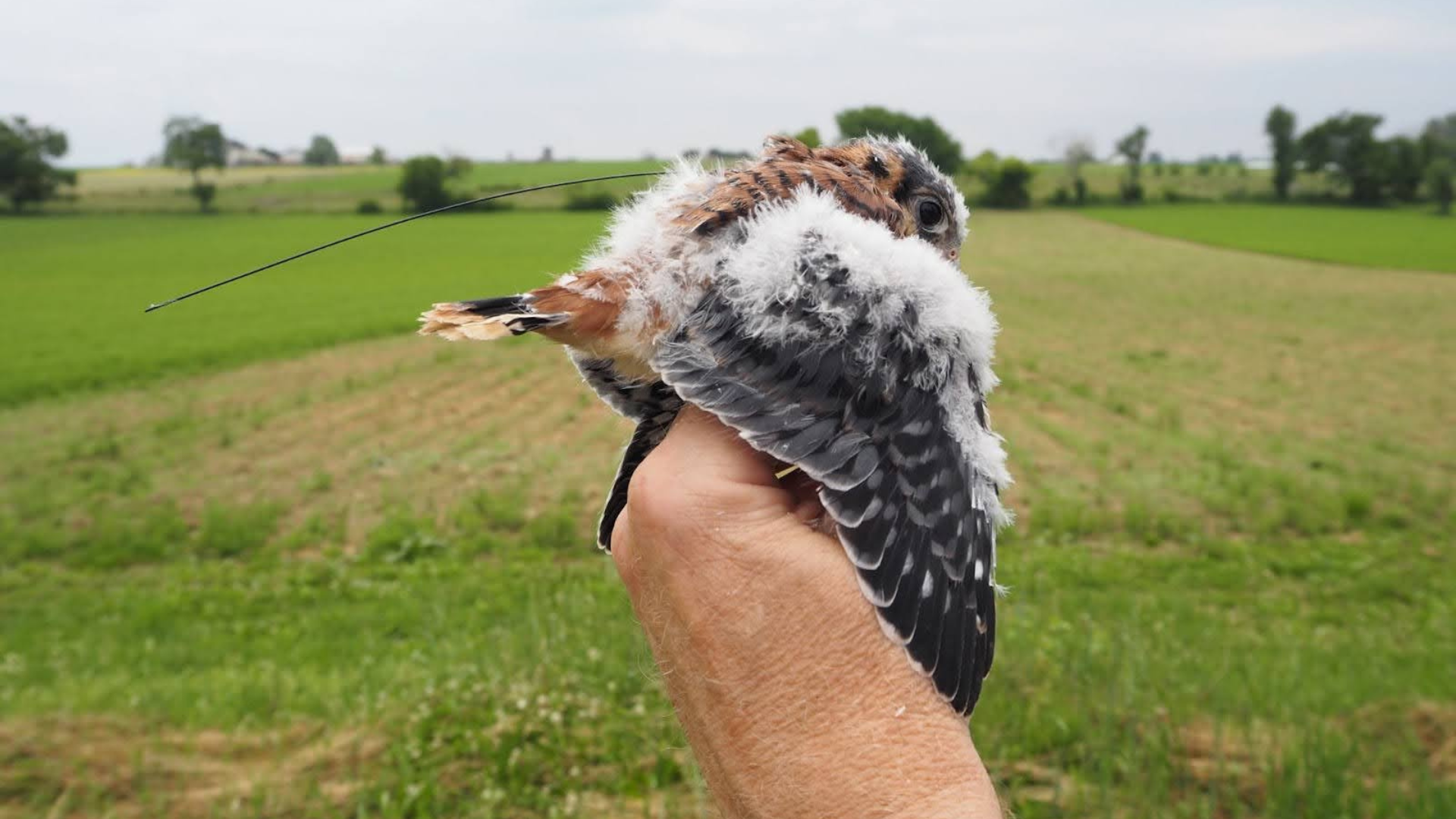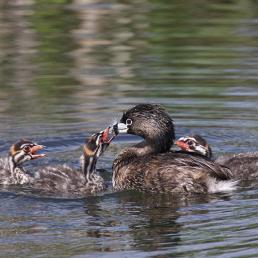

Join BirdNote tomorrow, November 30th!
Illustrator David Sibley and actor H. Jon Benjamin will face off in the bird illustration battle of the century during BirdNote's Year-end Celebration and Auction!
Congratulations to all of the winners of BirdNote's 19th Birthday Photo Contest!
Check out the top three winning submissions in both the General Bird Photography and Conservation Actions categories below. Thank you to everyone who participated in this year's contest!
General Bird Photography
First place: Robert Ho, Great Blue Heron

"I was walking back and forth trying to frame the Great Blue Heron with the moon together in one shot but I didn’t have much luck. So I stopped taking photos and pointed out the heron to people walking around the lake after work and all of a sudden the moon started to rise and the heron was miraculously positioned inside the moon, all I had to do was waited for its head to turn. I made a quick camera adjustment to manual focus and took the shot, totally lucky timing!" --Robert Ho
Second place: Janet Lewis, Sharp Tailed Grouse

"Working with a local guide I arrived at the Sharp Tailed Grouse lek well before sunrise. Pop-up blinds were set up and we were in place on a snowy field before the birds arrived. Total silence was necessary so as to not disturb the birds. They flew in shortly after sunrise and began their mating rituals. The males would flutter their wings, stomp their feet, puff out their purple air sacs and make a clicking noise. Then they would face off and spar, lunging at one another. The fights were short... usually just a few seconds long. Fast shutter speeds, high ISOs, patience and lots of hand and feet warmers were necessary to capture the action shown in images like the one submitted. In general the females were oblivious to the sparring males! After about 1.5-2 hours the birds took off as a flock to feed elsewhere." --Janet Lewis
Third place: Soo Baus, Green Heron

"This Green Heron nest was discovered across a slough in a business district while the chicks were still white and fluffy. It was such a joy to watch them grow. During one of our visits, there were two men from the American Conservation Experience clearing blackberry brushes close to the nest. They agreed to postpone the clearing project after we showed them the Green Heron chicks with our telescopic lens. They agreed to be back by the end of August or Septemeber. Finally, the three fledglings were learning to hunt. We, ladies, had so much fun giggling at their clumsiness balancing on branches and taking short flights to sand bars to hunt. This photograph has a special memory, it has the best lighting, the three little ones were very active and it was also the last time I could visit them." --Soo Baus
Conservation Actions
First place: James Shane, California Condor

"Wildlife Biologists with The Peregrine Fund, working in Northern Arizona, annually capture as many of the wild California Condors as possible to test them for lead poisoning. Lead Poisoning is the number 1 killer of California Condors. If a captured bird tests positive for lead it is taken to a care facility for treatment. If the treatments are successful, the condors are released back into the wild on this cliff over the Colorado River in The Grand Canyon. Here female California Condor number 16 is being released back into the wild. Sadly, in 2023 Number 16 contracted Avian Flu and died." --James Shane
Second place: Anthony Gehman, American Kestrel

"Growing marketable fruit is hard work. Doing it following principles of sustainable agriculture is harder still. Cooperation is one of the keys to how Kauffman Orchards does it. The image offered symbolizes how many folks can come together to enable human food production while maintaining healthy populations of beloved birds.
To begin with the big picture, we see the general habitat can be classified as agricultural. Kauffman Orchards is surrounded by pastures and row crop farmland. While that is good raptor foraging habitat, the absence of trees large enough to have cavities necessary for American Kestrel nesting is a problem. Installing nest boxes is a straightforward way to solve this problem. We have put up six nest kestrel nest boxes spread out over the 100 acre orchard. We did this knowing that kestrels prey on small rodents and large insects. These are the naturally occurring critters that would compromise a crop were they left unchecked. During most breeding seasons four of the six boxes successfully fledge kestrels.
To zoom in a little more on the image we see a hand holding a young kestrel. This bird is being held by a Pennsylvania State Game Biologist. Appropriately only those folks are authorized to open an active nest box. Since staff from the Game Commission know of the higher than normal population of American Kestrels at the orchard, they are keen to do some basic avian monitoring. This includes putting leg bands on young birds. Gathering life history data from band recovery is helpful in understanding what a particular species is vulnerable to. Their priority of resource protection and law enforcement is an important part of the equation.
At the finest level of detail the image shows a wire attached to the back of the bird. This is a radio antenna which is connected to a small transponder harnessed to the kestrel. Here is where another partner in working with these birds comes in. Researchers from Hawk Mountain Sanctuary are interested in understanding causes of recent declines in kestrel populations in Pennsylvania. Additional staff and money for equipment are needed to get a handle on what may be going on as regards this trend. Since they specialize in raptor research they are uniquely qualified to design and conduct avian research studies. Thankfully they have brought their expertise to the orchard.
The young American Kestrel in this picture is about to be put back in the nest box where he was born. In a couple of weeks he and his nest mates will leave the relative safety of their pine box home. Before this research effort what happens after they fledged has largely been a matter of speculation. It is generally believed that the first couple months after fledging is the period of highest mortality. But from what causes? Answering that question is a starting point to understanding population dynamics of this species.
What we know for sure is that everybody likes to have them as part of the living landscape. As government agencies, research institutions and land managers continue to look after these fierce little falcons, we educate the public in the best ways we know how. Seeing things from the orchard perspective I feel a deep satisfaction that comes from interacting with folks who come to the orchard to pick apples, or peaches or pears. I tell them about the nest boxes and why they are there. If we are lucky a kestrel will fly by and I can show them how beautiful it is beyond its function in the natural world." --Anthony Gehman
Third place: Georgia Wilson, Tufted Titmice

"This particular year, the Tufted Titmice used this box to nest in. It has also been used by Eastern Bluebirds and Great Crested Flycatchers. I was so excited the Titmice used it! I could tell when the babies hatched as parents started bringing in food regularly. After work, I would stand outside with camera on the tripod hoping to get this shot. I got a few in the sequence but this was my favorite. I used to live on five acres and when I moved into a neighborhood, I thought I would not see as many birds. I was wrong! If the right habitat is created, birds will come. I have also planted flowers to attract Hummingbirds and butterflies. I now have Ruby-throated Hummingbirds every year. At last count, I have had 45 species of birds in my yard, in the middle of a neighborhood!" --Georgia Wilson
You can help support BirdNote's storytelling and future contests like these by giving a gift to BirdNote. Your support will help BirdNote continue producing stories that inspire people to take action for birds and our shared world. We appreciate any amount you choose to give.
